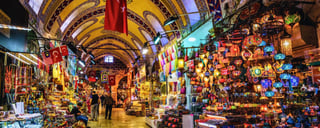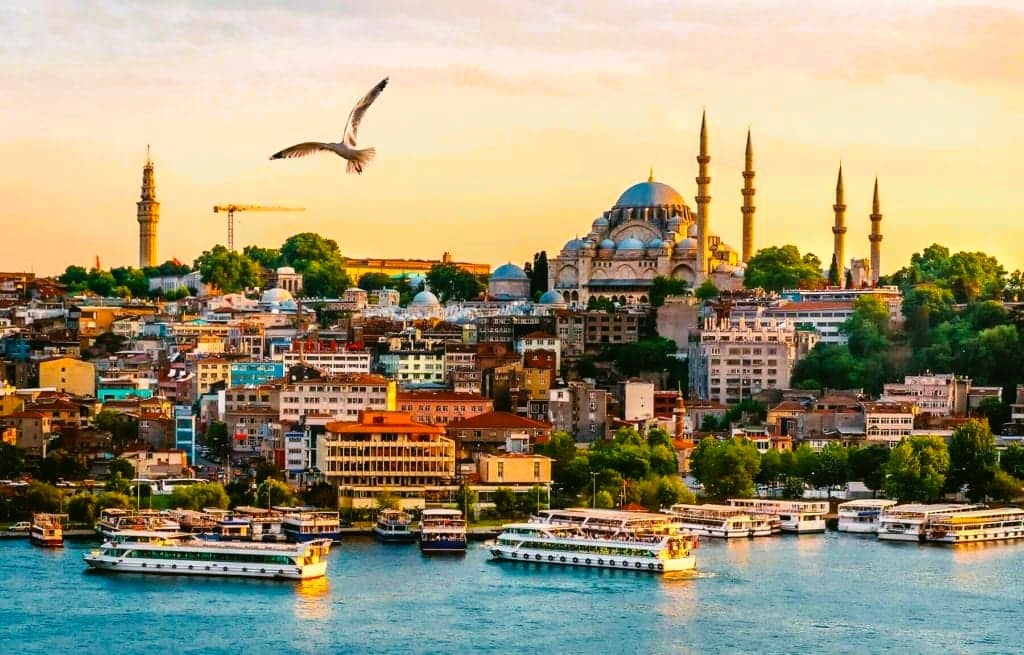Top Things To Do In Istanbul
Istanbul is a city that has something to offer everyone. Whether you are interested in history, culture, food, or the outdoors, you will find it in Istanbul. So what are you waiting for? Start planning your trip today!
Here Are Some Additional Information About Istanbul:
- Transportation: Istanbul has a vast transportation system, including a metro, tram, bus, and ferry system. The city is also served by two major airports: Istanbul Airport (IST) and Sabiha Gökçen International Airport (SAW).
- Food: Istanbul has a varied food culture, with influences from both Europe and Asia. Some of the most popular dishes include kebabs, pide (Turkish pizza), and baklava.
- Culture: Istanbul is a city with a rich history and culture. There are many museums, historical sites, and cultural attractions to visit.
- Religion: Istanbul is a religiously diverse city, with Muslims, Christians, and Jews all living together in harmony.
Here Are Some More Things To Do In Istanbul:
Take a Ferry Ride on The Bosphorus Strait

This is a great way to see the city from a different perspective and enjoy the stunning views of the sea and the surrounding mountains.The Bosphorus Strait is a narrow waterway that separates the European and Asian sides of Istanbul, connecting the Sea of Marmara to the Black Sea. Taking a ferry ride along the Bosphorus offers a unique perspective of the city and allows you to enjoy its stunning natural beauty and iconic landmarks.
Here Are Some Highlights Of A Bosphorus Ferry Ride:
- Scenic Views: As you cruise along the Bosphorus, you'll be treated to breathtaking views of Istanbul's skyline, historic palaces, elegant mansions, and picturesque waterfront neighborhoods. The sight of Ottoman-era buildings, mosques, and lush green hillsides creates a mesmerizing backdrop for your journey.
- Iconic Landmarks: The ferry ride takes you past several iconic landmarks, such as the majestic Dolmabahce Palace, the historic Rumeli Fortress, the iconic Maiden's Tower, and the ornate Beylerbeyi Palace. These landmarks are an integral part of Istanbul's history and offer fantastic photo opportunities from the water.
- Cultural Experience: The Bosphorus is a vital waterway, and during your ferry ride, you'll witness the bustling maritime activity, including cargo ships, fishing boats, and traditional Turkish wooden yachts known as "yali." You'll also have the chance to observe local life along the shores, with people strolling along waterfront promenades and enjoying picnics in parks.
- Bridge Crossing: One of the highlights of the ferry ride is passing under the famous Bosphorus Bridges. The most prominent is the Bosphorus Bridge (also known as the 15 July Martyrs Bridge), which connects the European and Asian sides of Istanbul. The sight of these architectural marvels is an impressive experience.
- Various Routes and Duration: There are different ferry routes available, ranging from shorter scenic cruises to longer trips that take you further along the Bosphorus. The duration of the rides varies depending on the route, but most ferry rides last between one to two hours.
- Affordable and Convenient: Ferry rides on the Bosphorus are a cost-effective way to explore the city and experience its natural beauty. The ferries are comfortable, with both indoor and outdoor seating options, and they offer a refreshing break from the bustling city streets.
Whether you choose a short scenic cruise or a longer journey, a ferry ride on the Bosphorus Strait is a memorable experience that allows you to appreciate Istanbul's unique geographical location and its rich cultural heritage. Don't forget to bring your camera to capture the stunning vistas and create lasting memories of your time in Istanbul.
Visit The Grand Bazaar:

This is one of the largest and oldest covered markets in the world, and it is a great place to find souvenirs and traditional Turkish handicrafts.Visiting the Grand Bazaar is a must-do activity for any visitor to Istanbul. Here's some information about this iconic and vibrant marketplace:The Grand Bazaar, known as Kapalıçarşı in Turkish, is one of the oldest and largest covered markets in the world. Located in the heart of Istanbul's historic Sultanahmet district, it spans over 61 streets and consists of more than 4,000 shops.
Here Are Some Highlights Of A Visit To The Grand Bazaar:
- History and Architecture: The Grand Bazaar has a rich history that dates back to the 15th century. It was initially built as a small vaulted bedesten (covered market) and expanded over the centuries. The architecture of the bazaar is impressive, with its domes, arched entrances, and intricate tile work, showcasing a blend of Ottoman and Byzantine styles.
- Vast Variety of Goods: The Grand Bazaar offers an overwhelming array of goods to explore. You'll find shops selling everything from jewelry, textiles, ceramics, and leather goods to spices, carpets, traditional Turkish handicrafts, and souvenirs. The bazaar is divided into different sections, each specializing in specific products, making it easier to navigate and find what you're looking for.
- Bargaining and Haggling: Bargaining is a common practice in the Grand Bazaar, and it's part of the shopping experience. Sellers expect customers to negotiate prices, so don't hesitate to engage in friendly haggling. Just remember to be respectful and have fun while trying to secure a good deal.
- Cultural Immersion: The Grand Bazaar is not just a shopping destination; it's also a cultural hub where locals and visitors come together. As you wander through the labyrinthine alleys, you'll experience the vibrant atmosphere, bustling crowds, and the sound of merchants enthusiastically promoting their goods. It's a fascinating opportunity to observe Turkish culture, interact with shopkeepers, and immerse yourself in the local ambiance.
- Turkish Hospitality: The shopkeepers in the Grand Bazaar are known for their warm hospitality. Even if you're not planning to make a purchase, they will welcome you into their shops, offer tea, and engage in friendly conversations. It's a chance to learn about Turkish customs, traditions, and local insights.
- Food and Refreshments: Within the Grand Bazaar, you'll find numerous small eateries, cafes, and tea houses where you can take a break and sample Turkish delights. Don't miss the opportunity to try traditional Turkish tea, Turkish coffee, and delicious street food like kebabs, pide (Turkish pizza), and baklava.
Visiting the Grand Bazaar is a sensory overload of sights, sounds, and aromas, and it provides a unique shopping experience. Whether you're searching for souvenirs, unique handcrafted items, or simply want to soak up the vibrant atmosphere, a visit to the Grand Bazaar is an essential part of your Istanbul itinerary. Just remember to come with an open mind, be prepared for a bit of haggling, and enjoy the cultural immersion this iconic marketplace offers.
Explore The Spice Bazaar:

This market is a great place to find spices, herbs, and other Turkish delicacies. Exploring the Spice Bazaar, also known as the Egyptian Bazaar or Misir Çarşısı in Turkish, is a delightful sensory experience in Istanbul.
Here's What You Can Expect When You Visit This Historic Market:
- Aromatic Delights: The Spice Bazaar is famous for its rich aromas and colorful displays of spices, herbs, and other culinary ingredients. As you enter the bazaar, you'll be greeted by the enticing scents of various spices like saffron, sumac, cumin, cinnamon, and many more. The market is a treasure trove for food enthusiasts and those seeking unique flavors and ingredients.
- Variety of Products: While spices take center stage, the Spice Bazaar also offers a wide range of other products. You'll find stalls selling dried fruits, nuts, Turkish delight, tea, coffee, natural soaps, traditional sweets, and even herbal remedies. It's an opportunity to explore the vibrant culinary culture of Turkey and discover unique ingredients for your own cooking or as souvenirs to take home.
- Historical Atmosphere: The Spice Bazaar has a rich history dating back to the 17th century. It was originally established to provide income for the New Mosque (Yeni Camii) complex nearby. The architecture reflects the Ottoman period with its domed structure and intricate tile work. As you stroll through the market's narrow aisles, you'll feel the sense of history and tradition.
- Engaging with the Vendors: The friendly and welcoming vendors add to the charm of the Spice Bazaar. They are passionate about their products and are happy to share their knowledge, offer samples, and engage in conversations. Don't hesitate to ask questions, seek recommendations, and learn about the various spices and culinary traditions.
- Local Food Products: In addition to spices and herbs, you'll find a variety of local food products at the Spice Bazaar. These include olive oil, honey, dried fruits, Turkish cheeses, and traditional pastes like tahini and pomegranate molasses. It's an opportunity to taste and appreciate the rich flavors of Turkish cuisine.
- Traditional Turkish Tea and Coffee: Within the Spice Bazaar, you'll find tea houses and coffee shops where you can take a break and enjoy a cup of traditional Turkish tea or coffee. Sit back, relax, and immerse yourself in the lively atmosphere while savoring the flavors of these iconic Turkish beverages.
- Souvenirs and Gifts: The Spice Bazaar is an excellent place to find unique souvenirs and gifts. Whether you're looking for small packets of spices, beautifully packaged Turkish delight, or handmade natural soaps, you'll find plenty of options to choose from. The market offers an authentic and culturally rich alternative to mass-produced souvenirs.
Visiting the Spice Bazaar is a feast for the senses, offering a glimpse into the vibrant culinary culture of Istanbul. It's a chance to explore unique flavors, engage with friendly vendors, and soak up the historical atmosphere. Make sure to take your time, savor the scents, and indulge in the rich heritage of Turkish spices and culinary delights.
Visit a Hammam:

This is a traditional Turkish bathhouse, and it is a great way to relax and rejuvenate. Visiting a hammam, also known as a Turkish bath, is a traditional and rejuvenating experience that you can enjoy during your stay in Turkey.
Here's What You Can Expect When You Visit A Hammam:
- Ancient Tradition: Hammams have been an integral part of Turkish culture for centuries, and they have a long history dating back to the Roman and Byzantine periods. These public bathing establishments were not only a place for cleanliness but also served as social gathering spots.
- Relaxation and Cleansing: The main purpose of a hammam visit is to relax, cleanse the body, and rejuvenate the mind. The hammam consists of several heated rooms with different temperature levels. You'll start in the warm room to loosen up your muscles and open your pores. Then, you move to the hot room, where you'll experience intense heat and steam. This helps to detoxify the body and promote sweating. Finally, you'll cool down in the cold room or with a refreshing dip in a cold pool or shower.
- Exfoliation and Massage: One of the highlights of a hammam experience is the exfoliation and massage. Once your body is warmed up and your skin is moist, an attendant (known as a tellak in Turkish) will scrub your body with a special exfoliating glove called a kese. This scrubbing removes dead skin cells, leaving your skin smooth and refreshed. Afterward, you can opt for a relaxing massage with fragrant oils to further enhance the experience.
- Cultural Immersion: Visiting a hammam offers a glimpse into Turkish customs and traditions. You'll have the opportunity to interact with locals, experience the ritual of bathing, and gain insight into the significance of hammams in Turkish culture. It's a chance to connect with the local way of life and immerse yourself in the cultural heritage of the country.
- Health Benefits: Hammams are not just about relaxation; they also offer several health benefits. The steam and heat help to improve blood circulation, relieve muscle tension, and open up the pores for deep cleansing. The exfoliation removes impurities and dead skin cells, leaving your skin smooth and rejuvenated. Many people also find hammam visits beneficial for respiratory health and stress relief.
- Choose Your Hammam Experience: There are different types of hammams to choose from, ranging from historic and traditional establishments to modern spa-like settings. Some hammams cater primarily to locals, while others are more tourist-oriented. Depending on your preferences, you can opt for a more authentic and rustic hammam experience or a luxurious spa-like setting with additional amenities like aromatherapy, sauna, or jacuzzi.
- Cultural Etiquette: When visiting a hammam, it's important to be aware of cultural etiquette. Generally, hammams are separated by gender, with separate sections for men and women or designated days for each gender. It's customary to bring your own towel, flip-flops, and personal toiletries. Modesty is also important, and most hammams provide a waistcloth or pestemal for you to wear during the bathing process.
Visiting a hammam is a unique and cultural experience that allows you to relax, rejuvenate, and immerse yourself in Turkish customs. It's an opportunity to take a break from your daily routine, indulge in self-care, and discover the rich heritage of Turkish bathing traditions.
Enjoy The Nightlife in Istanbul:

Istanbul has a vibrant and diverse nightlife scene that offers something for everyone.
Here Are Some Popular Options For Enjoying The Nightlife In Istanbul:
- Istiklal Avenue: Located in the heart of Istanbul, Istiklal Avenue is a bustling pedestrian street lined with shops, restaurants, cafes, bars, and clubs. It comes alive at night with a lively atmosphere and offers a mix of music venues, rooftop bars, and dance clubs.
- Beyoglu: This neighborhood is known for its vibrant nightlife, particularly in areas such as Nevizade Street and Asmalimescit Street. Here, you'll find a wide range of bars, pubs, and live music venues where you can enjoy drinks, socialize, and listen to live bands or DJs.
- Kadikoy: Located on the Asian side of Istanbul, Kadikoy is a hip and trendy neighborhood with a vibrant nightlife scene. It's popular among locals and offers a mix of cozy bars, live music venues, and alternative clubs. Kadikoy is known for its bohemian atmosphere and laid-back vibes.
- Bosphorus Night Cruise: Enjoying a night cruise along the Bosphorus Strait is a romantic and memorable way to experience Istanbul's nightlife. You can savor dinner and drinks onboard while admiring the illuminated city skyline, historic landmarks, and waterfront mansions.
- Rooftop Bars: Istanbul boasts several rooftop bars and terraces that offer breathtaking views of the city skyline. These venues are perfect for enjoying a cocktail or a glass of wine while taking in panoramic views of iconic landmarks such as the Hagia Sophia, Blue Mosque, and the Bosphorus.
- Live Music and Jazz Clubs: Istanbul has a thriving live music and jazz scene, with numerous venues showcasing talented musicians and bands. Nardis Jazz Club, Babylon Bomonti, and Salon IKSV are popular venues known for their live music performances across a variety of genres.
- Turkish Night Shows: Experience traditional Turkish culture and entertainment by attending a Turkish night show. These shows often include live music, folk dances, belly dancing, and traditional performances, along with a delicious dinner of Turkish cuisine.
- Karakoy and Galata: These neighborhoods offer a mix of trendy bars, hipster cafes, and art galleries. Karakoy is known for its stylish and contemporary venues, while Galata boasts a bohemian vibe with cozy bars and underground music scenes.
- Clubbing: Istanbul has a vibrant clubbing scene, with numerous clubs catering to various music genres, including electronic, techno, hip-hop, and pop. Some popular clubs include Reina, Sortie, Klein, and Indigo.
- Street Food and Night Markets: Istanbul is famous for its street food culture, and you can explore food stalls and night markets that come alive after dark. Try traditional snacks like simit (sesame bread rings), kebabs, roasted chestnuts, and Turkish desserts as you wander through the lively streets.
Try The Food:

Istanbul is indeed a foodie's paradise, offering a rich culinary experience with a wide variety of delicious dishes influenced by both Ottoman and international cuisines.
Here Are Some Must-Try Food Experiences In Istanbul:
- Kebabs: Indulge in mouthwatering kebabs, including döner kebab (thinly sliced, marinated meat cooked on a vertical rotisserie), şiş kebab (skewered and grilled meat), and adana kebab (spicy minced meat grilled on skewers).
- Street Food: Explore the vibrant street food scene in Istanbul. Try simit (sesame-covered bread rings), balık ekmek (grilled fish sandwich), midye dolma (stuffed mussels), and lahmacun (Turkish pizza topped with minced meat and vegetables).
- Meze: Experience the flavors of Turkish meze, which are small dishes served as appetizers or shared plates. Enjoy classics like hummus, tabbouleh, dolma (stuffed grape leaves), and cacık (yogurt with cucumbers and herbs).
- Turkish Breakfast: Start your day with a traditional Turkish breakfast, known as kahvaltı. This typically includes a variety of cheeses, olives, tomatoes, cucumbers, honey, jams, fresh bread, and eggs prepared in various ways.
- Turkish Tea and Coffee: Sip on traditional Turkish tea (çay) served in delicate tulip-shaped glasses, and don't miss out on trying Turkish coffee (Türk kahvesi), a strong and aromatic coffee traditionally brewed in a special copper pot.
- Baklava and Turkish Delight: Treat yourself to sweet delights like baklava, a rich pastry made of layers of filo dough filled with nuts and sweet syrup, and Turkish delight (lokum), a gelatine-based confectionary with various flavors and textures.
- Seafood: Being a coastal city, Istanbul offers a fantastic selection of seafood. Try fresh fish and seafood dishes such as grilled sea bass (levrek), fried calamari (kalamar), or shrimp casserole (karides güveç).
- Pide: Sample pide, a delicious Turkish flatbread topped with various ingredients such as cheese, ground meat, vegetables, and herbs. It's similar to pizza but with a unique Turkish twist.
- Turkish Desserts: Indulge in a range of traditional Turkish desserts like künefe (shredded pastry with cheese and syrup), sutlac (rice pudding), şekerpare (soft cookies soaked in syrup), and revani (semolina sponge cake).
- Lokantas: Visit a lokanta, a type of casual eatery where you can enjoy home-style Turkish dishes. These restaurants offer a variety of dishes, including stews, vegetable-based dishes, and grilled meats.
Exploring Istanbul's culinary scene is a delightful experience that combines flavors, aromas, and the rich history of Turkish cuisine. Don't miss the chance to immerse yourself in the diverse and delicious food culture that Istanbul has to offer.
Visit The Mosques:

Istanbul is home to several stunning mosques that are not only architectural marvels but also important cultural and religious sites.
Here Are Some Mosques You Should Consider Visiting In Istanbul:
- Hagia Sophia: Originally built as a Christian basilica in the 6th century, Hagia Sophia later became a mosque and is now a museum. It is renowned for its massive dome, stunning mosaics, and unique blend of Byzantine and Ottoman architectural styles.
- Blue Mosque (Sultan Ahmed Mosque): Known for its iconic blue tiles, the Blue Mosque is one of Istanbul's most famous landmarks. It features six minarets and a grand interior adorned with intricate tilework and beautiful calligraphy.
- Suleymaniye Mosque: This mosque, built during the Ottoman Empire, is a masterpiece of Ottoman architecture. Its grand dome, elegant minarets, and expansive courtyard make it an impressive sight. The interior is equally breathtaking, with stunning tilework and intricate designs.
- Rustem Pasha Mosque: Located in the historic Eminonu district, this small mosque is known for its exquisite Iznik tilework. The walls and interior are adorned with colorful floral patterns, creating a visually stunning atmosphere.
- New Mosque (Yeni Camii): Situated near the Spice Bazaar, the New Mosque is a beautiful example of Ottoman architecture. Its large courtyard, impressive dome, and intricate details make it worth a visit.
- Eyup Sultan Mosque: Located in the Eyup district, this mosque is an important pilgrimage site for Muslims. It has a serene atmosphere and offers panoramic views of the Golden Horn.
- Ortakoy Mosque: Situated by the Bosphorus, Ortakoy Mosque is known for its picturesque location and stunning views. Its elegant design, featuring a large central dome and two minarets, is a sight to behold.
Remember to dress modestly and respect the religious significance of these mosques when visiting. It is customary to remove your shoes before entering and to cover your shoulders, knees, and head (for women). Exploring these mosques will not only give you a glimpse into the architectural splendor of Istanbul but also provide insight into the city's rich cultural and religious heritage.
Explore The Neighborhoods:

Istanbul is a sprawling city with diverse neighborhoods, each with its own unique character, history, and attractions.
Here Are Some Neighborhoods Worth Exploring In Istanbul:
- Sultanahmet: This historic district is home to many of Istanbul's iconic landmarks, including the Hagia Sophia, Blue Mosque, Topkapi Palace, and the Basilica Cistern. It offers a glimpse into Istanbul's rich Byzantine and Ottoman history.
- Beyoglu: Located on the European side of Istanbul, Beyoglu is known for its vibrant atmosphere and bustling streets. Istiklal Avenue, the main thoroughfare, is lined with shops, restaurants, cafes, and historical buildings. This neighborhood is also home to the famous Galata Tower and the trendy area of Karakoy.
- Kadikoy: Situated on the Asian side of Istanbul, Kadikoy is a lively neighborhood with a bohemian vibe. It offers a vibrant food scene, bustling markets, and an array of shops, cafes, and bars. Moda, a coastal district within Kadikoy, is a popular spot for strolling along the waterfront and enjoying the local atmosphere.
- Karakoy: Located on the European side, Karakoy is a trendy neighborhood that has undergone significant transformation in recent years. It features a mix of historic buildings, hip cafes, art galleries, and design shops. Karakoy is also known for its vibrant street art scene.
- Ortakoy: Situated by the Bosphorus, Ortakoy is known for its picturesque location and lively atmosphere. The neighborhood is famous for its waterfront square, Ortakoy Mosque, and its vibrant arts and crafts market. It's a popular spot for locals and tourists alike, especially during weekends.
- Uskudar: On the Asian side, Uskudar offers a more traditional and relaxed atmosphere. It is home to historic landmarks such as the Maiden's Tower and the Beylerbeyi Palace. Uskudar is known for its stunning views of the Bosphorus and its charming streets lined with tea gardens and Ottoman-era buildings.
- Balat: Located on the Golden Horn, Balat is a colorful and multicultural neighborhood known for its historic houses, narrow streets, and vibrant street art. It's a great place to explore and discover hidden gems, local cafes, and antique shops.
These are just a few of the many neighborhoods in Istanbul, each offering its own unique charm and experiences. Exploring the different districts will give you a deeper understanding of the city's diverse culture, history, and local lifestyle.
Learn About The history:

Istanbul is a city with a rich and diverse history that spans over two millennia. Learning about its history is a fascinating journey that reveals the city's layers of civilizations and cultural influences.
Here Are Some Key Aspects Of Istanbul's History:
- Byzantine Era: Istanbul, then known as Constantinople, served as the capital of the Byzantine Empire for over a thousand years. During this period, many iconic structures were built, including the Hagia Sophia, the Hippodrome, and the Theodosian Walls. The Byzantine era marked a significant period in the city's history, blending Roman, Greek, and Christian influences.
- Ottoman Empire: Istanbul became the capital of the Ottoman Empire in 1453 when Mehmed the Conqueror captured the city. The Ottomans brought Islamic and Turkish traditions to Istanbul and left an indelible mark on its architecture and culture. The city flourished under Ottoman rule, and remarkable structures such as the Topkapi Palace, the Blue Mosque, and the Süleymaniye Mosque were constructed.
- Republic Era: Following the fall of the Ottoman Empire, Istanbul became a crucial center during the establishment of the modern Republic of Turkey. Under the leadership of Mustafa Kemal Atatürk, Istanbul underwent significant transformations, including the shift of the capital to Ankara. The city experienced modernization and urban development, while preserving its historical heritage.
- Cultural Heritage: Istanbul's rich history is reflected in its cultural heritage, museums, and archaeological sites. The Istanbul Archaeological Museums, including the Archaeological Museum, the Museum of the Ancient Orient, and the Museum of Islamic Art, house extensive collections of artifacts from various civilizations. The Chora Museum, known for its Byzantine mosaics and frescoes, provides insight into the city's religious art.
- Historical Sites: Exploring the city's historical sites is a remarkable way to delve into Istanbul's history. The Hagia Sophia, initially a Byzantine church, later converted into a mosque, and now a museum, exemplifies the architectural and cultural transitions the city has experienced. Other notable sites include the Topkapi Palace, the Basilica Cistern, the Galata Tower, and the Byzantine city walls.
- Preservation Efforts: Istanbul has made significant efforts to preserve its historical sites and protect its cultural heritage. UNESCO has recognized several sites in Istanbul as World Heritage Sites, including the Historic Areas of Istanbul, the Suleymaniye Mosque, and the Archaeological Site of Troy.
Exploring Istanbul's history allows you to appreciate the city's cultural tapestry and its role as a bridge between civilizations. By visiting its museums, historical sites, and engaging with local guides, you can gain a deeper understanding of Istanbul's captivating past and its place in shaping Turkey's identity.

